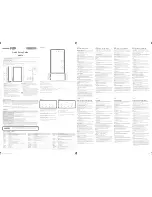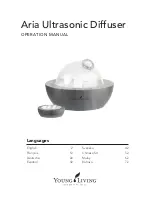
Tophit H CPS471/CPS471D
2
Hauser
Function and system design
Measuring principle
Ion-
selective
, or more generally ion-
sensitive
field effect transistors (ISFET) were developed in the 1970s as
an alternative to the glass electrode for pH measurement.
Basics
Ion-selective field effect transistors use an MOS
1)
transistor arrangement (
gate
(pos. 1) is not a control electrode. Instead, the medium (
2, pos. 3) in the ISFET is in direct contact with
the gate isolator layer (pos. 2).Two strongly N-conducting areas are diffused in P-conducting substrate
(
2, pos. 5) of the semiconductor material (Si). These N-conducting areas are current supplying
("
Source
", S) and current accepting ("
Drain
", D) electrodes. The metallic gate electrode (in case of the
MOSFET) resp. the medium (in case of the ISFET) forms a capacitor with the substrate below. A potential
difference between gate and substrate (U
GS
) causes a higher electron density between "Source" and "Drain". A
N-conducting
channel
(pos. 2) is formed, i.e. a drain current (I
D
) is induced.
With the ISFET, the medium is in direct contact with the gate isolator layer. Therefore, H
+
ions available in the
medium, which are located in the medium / gate isolator boundary layer, create the electric field (
gate
potential
). Depending on the effect described above, a N-conducting channel is formed and a current between
"Source" and "Drain" is induced. Suitable sensor circuits use the dependence on the ion-selective gate potential
to create an output signal proportional to the concentration of the ion type.
pH selective IsFET
The gate isolator serves as an ion-selective layer for H
+
ions. The gate isolator is impermeable to the ions as
well (isolator effect) but allows reversible surface reactions with the H
+
ions.
Depending on the acidic or alkaline character of the measurement solutions, functional groups in the isolator
surface accept or reject H
+
ions (amphoteric character of the functional groups). This leads to a
positive
(H
+
acceptance in the acidic medium) or
negative
(H
+
rejection in the alkaline medium) charging of the isolator
surface. Depending on the pH value, a defined surface charge can be used to control the field effect in the
channel between "Source" and "Drain".The processes which lead to the creation of a charge potential and
therefore to a control voltage U
GS
between "Gate" and "Source" are described with the Nernst equation:
At 25 °C (77 °F), the Nernst factor is –59.16 mV/pH.
1)
Metal Oxide Semiconductor
a0003855
Fig. 1:
Principle MOSFET
1
Metallic gate
2
N-conducting channel
a0003856
Fig. 2:
Principle ISFET
1
Reference electrode
2
N-conducting channel
3
Gate isolator layer
4
Medium
5
P-doped silicon substrate
6
Sensor shaft
U
D
U
GS
1
2
S
D
Si (p)
Si (n)
Si (n)
I
D
U
D
U
GS
1
3
4
5
6
2
S
D
Si (p)
Si (n)
Si (n)
I
D
U
GS
...
U
0
...
R ...
T ...
n ...
Potential between gate and source
Offset voltage
Gas constant (8.3143 J/molK)
Temperature [K]
electrochemical valueability (1/mol)
F ...
a
ion
...
Faraday constant (26.803 Ah)
Activity of ion kind (H
+
)
Nernst factor



































